Sony D-E999, D-EJ925 User Manual
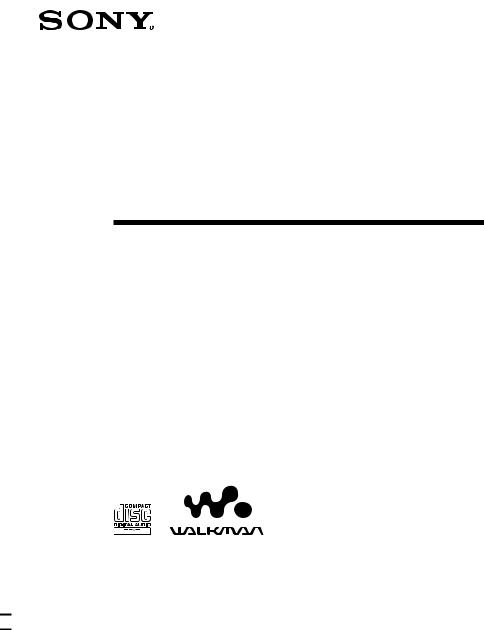
3-221-695-22 (1)
Portable
CD Player
Operating Instructions
About the area code
The area code of the location in which you purchased the CD player is shown on upper left of the bar code label on the package.
For accessories supplied with your CD player, check the area code of your model and see “Accessories (supplied/optional).”
D-E999
D-EJ925
© 2000 Sony Corporation
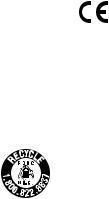
CAUTION
The use of optical instruments with this product will increase eye hazard.
Owner’s Record
The model number is located at the rear and the serial number is located inside the lid of the CD player. Record these numbers in the spaces provided below. Refer to them whenever you call upon your Sony dealer regarding this product.
Model No. ___________________
Serial No. ___________________
Certain countries may regulate disposal of the battery used to power this product. Please consult with your local authority.
For the customers in the USA and Canada
DISPOSAL OF NICKEL METAL HYDRIDE BATTERY.
NICKEL METAL HYDRIDE BATTERY. DISPOSE OF PROPERLY.
You can return your unwanted nickel metal hydride batteries to your nearest Sony Service Center or Factory Service Center.
Note: In some areas the disposal of nickel metal hydride batteries in household or business trash may be prohibited.
For the Sony Service Center nearest you call 1-800- 222-SONY (United States only)
For the Sony Factory Service Center nearest you call 416-499-SONY (Canada only)
Caution: Do not handle damaged or leaking nickel metal hydride battery.
For the customers in the USA and Canada
This mark is available in the USA and Canada only
RECYCLING NICKEL-CADMIUM BATTERIES
Nickel-Cadmium batteries are recyclable. You can help preserve our environment by returning your unwanted batteries to your nearest point for collection, recycling or proper disposal. Note: In some areas the disposal of
nickel-cadmium batteries in household or business trash may be prohibited.
RBRC (Rechargeable Battery Recycling Corporation) advises you about spent battery collection by the following phone number.
Call toll free number: 1-800-822-8837 (United States and Canada only)
Caution: Do not handle damaged or leaking nickelcadmium batteries.
For the customers in the USA
This equipment has been tested and found to comply with the limits for a Class B digital device, pursuant to Part 15 of the FCC Rules. These limits are designed to provide reasonable protection against harmful interference in a residential installation. This equipment generates, uses, and can radiate radio frequency energy and, if not installed and used in accordance with the instructions, may cause harmful interference to radio communications. However, there is no guarantee that interference will not occur in a particular installation. If this equipment does cause harmful interference to radio or television reception, which can be determined by turning the equipment off and on, the user is encouraged to try to correct the interference by one or more of the following measures:
–Reorient or relocate the receiving antenna.
–Increase the separation between the equipment and receiver.
–Connect the equipment into an outlet on a circuit different from that to which the receiver is connected.
–Consult the dealer or an experienced radio/TV technician for help.
You are cautioned that any changes or modifications not expressly approved in this manual could void your authority to operate this equipment.
For the customers in Australia
The supply cord of the AC power adaptor cannot be replaced; if the cord is damaged, the AC power adaptor should be discarded.
The CE mark on the CD player is valid only for products marketed in the European Union.
2
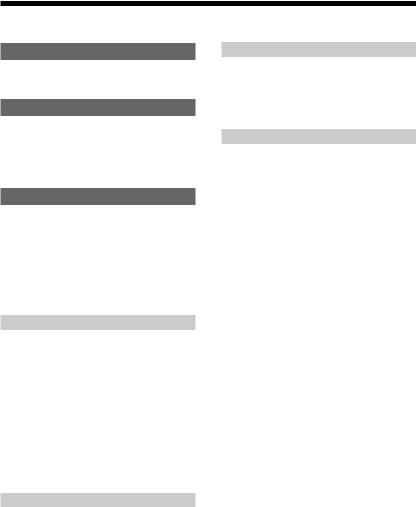
Table of Contents |
|
Getting started |
|
Locating the controls ................................... |
4 |
Playing a CD |
|
1. Connect your CD player. ......................... |
7 |
2. Insert a CD. ............................................. |
7 |
3. Play a CD. ............................................... |
8 |
Playback options |
|
Playing tracks repeatedly (Repeat play) .... |
11 |
Playing a single track (Single play) ........... |
11 |
Playing tracks in random order |
|
(Shuffle play) ......................................... |
11 |
Playing tracks in your favorite order |
|
(PGM play) ............................................ |
12 |
Available features |
|
G-PROTECTION function ........................ |
13 |
Displaying CD text information ................ |
13 |
Checking the remaining time on the CD and |
|
the number of tracks left ....................... |
14 |
Emphasizing the bass sound (SOUND) .... |
14 |
Protecting your hearing (AVLS) ................ |
15 |
Locking the controls (HOLD) ................... |
15 |
Turning off the operation beep sound ........ |
16 |
Turning off the LCD’s backlight ............... |
16 |
Connecting your CD player |
|
Connecting a stereo system ....................... |
17 |
Using your CD player in a car ................... |
18 |
Connecting a power source |
|
Using the rechargeable batteries ................ |
19 |
Using the dry batteries ............................... |
21 |
Notes on the power source ........................ |
22 |
Additional information |
|
Precautions ................................................ |
23 |
Maintenance .............................................. |
23 |
Troubleshooting ......................................... |
24 |
Specifications ............................................ |
26 |
Accessories (supplied/optional) ................ |
27 |
3
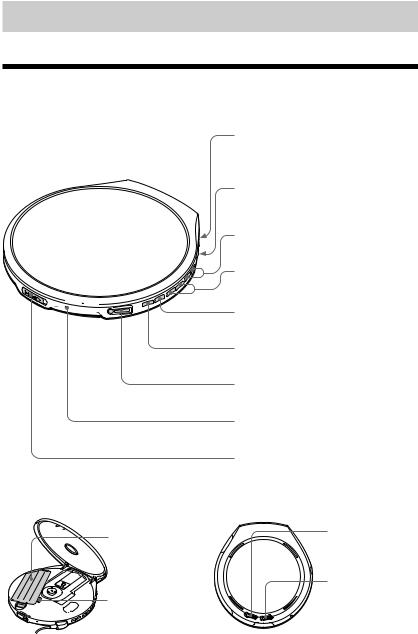
Getting started
Locating the controls
For details, see pages in parentheses.
CD player (front)
CD player (inside)
q; Battery compartment (pages 19)
qa G-PRO (G- PROTECTION) switch
(page 13)
4
1EXT BATT (external battery)/ DC IN 4.5 V (external power input) jack (pages 7, 19, 21)
2LINE OUT (OPTICAL) jack (page 17)
3VOL (volume) +/– buttons (page 8)
4 ./> (AMS/search) buttons
(pages 8, 11, 12)
5 u (play/pause) button (page 8)
6 x (stop) /CHG (charge) button (pages 8, 16, 19)
7 i (headphones) jack (page 7)
8CHG (charge)/HOLD lamp (pages 15, 19)
9OPEN switch (page 7)
CD player (rear)
qs AVLS switch (page 15)
qd HOLD switch (page 15)

Remote control
qf Display
(pages 9, 11 - 15)
qg Rotary control
N/>: play, AMS/search (pages 8, 11, 12)
.: AMS/search (pages 8, 11, 12)
VOL +/–: Pull the control in the direction of the arrow, and then turn it toward + or –. (page 8)
qh x (stop) button (pages 8, 16)
started Getting
qj Clip
qk DISPLAY button
(pages 13, 14)
ql PLAY MODE button
(pages 10 - 12, 16)
w; RPT (repeat)/ENT (enter) button (pages 10 - 12)
wa HOLD switch (page 15)
ws i (headphones) jack (page 7)
wd X (pause) button (page 8)
wf SOUND button (page 14)
Note
Use only the supplied remote control. You cannot operate this CD player with the remote control supplied with other CD players.
5
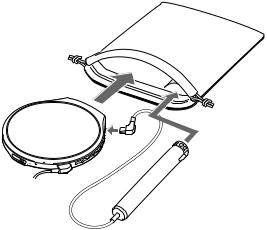
Using the carrying case
You can carry your player and its battery case together using the supplied carrying case. Insert them into the proper places in the case as illustrated below.
6
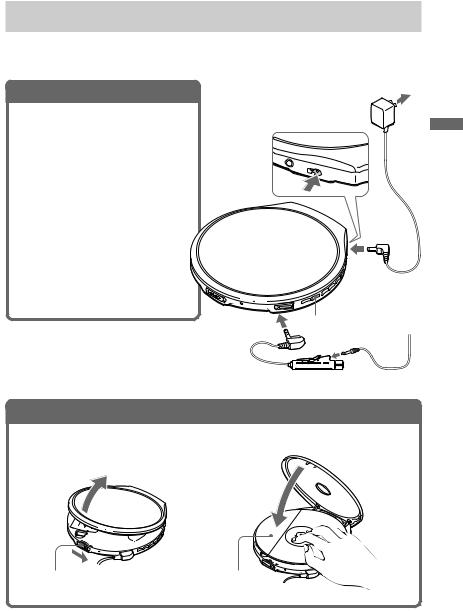
Playing a CD
You can also use rechargeable batteries, dry batteries and a car battery as a power source.
1. Connect your CD player.
1 Connect the AC power adaptor.
2Connect the headphones/earphones with remote control.
For models supplied with the AC plug adaptor
If the AC power adaptor does not fit the AC outlet, use the AC plug adaptor.
For models supplied with the remote control.
•Connect the plug of the headphones/ earphones to the remote control.
•Connect the headphones/earphones to the remote control firmly. A loose connection may cause noise during playback.
to an AC outlet
AC power adaptor
to EXT BATT/DC IN 4.5V
|
Headphones |
|
or |
to i |
u button Earphones |
|
CD a Playing
2. Insert a CD.
1Slide OPEN to open the CD player lid.
OPEN switch
2Place the CD on the tray and close the lid.
Label side up
(Continued)
7

3. Play a CD.
VOL + / –
u
1Press u.
2Adjust the volume by pressing VOL + or –.
N/>
1Turn the rotary control toward N/> or ..
2Pull the rotary control in the direction of the arrow.
3Adjust the volume by turning the rotary control toward VOL + or –.
To |
Do this on the remote control |
Play |
Turn the rotary control toward |
|
N/ > or . (press u for the CD |
|
player). |
|
|
Pause |
Press X (u for the CD player). |
|
|
Stop |
Press x (x/CHG for the CD player).*2 |
Find the beginning of the current track (AMS*1) |
Turn the rotary control toward . |
|
once.*2 |
Find the beginning of the previous tracks (AMS) |
Turn the rotary control toward . |
|
repeatedly.*2 |
Find the beginning of the next track (AMS) |
Turn the rotary control toward |
|
N/ > once.*2 |
Find the beginning of the succeeding tracks (AMS) |
Turn the rotary control toward |
|
N/ > repeatedly.*2 |
Go backwards quickly |
Turn the rotary control toward . and |
|
hold it.*2 |
Go forward quickly |
Turn the rotary control toward |
|
N/ > and hold it.*2 |
*1 Automatic Music Sensor
*2 These operations can be done during both play and pause.
8
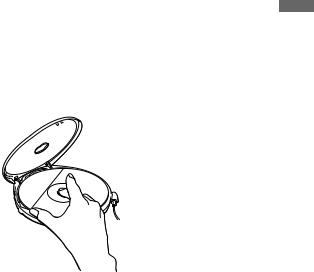
About the display
•When you turn the rotary control toward N/> or . (press u for the CD player) after changing the CD or turning off and on the player, the total number of tracks in the CD and total playing time appear for about two seconds.
•During play, the track number and the elapsed playing time of the current track appear.
•Between tracks, the time to the beginning of the next track appears with the “–” indication.
•During pause, the elapsed playing time flashes.
If the volume level does not increase
Is AVLS set to “LIMIT”? Set AVLS to “NORM.” For details, see “Protecting your hearing (AVLS).”
Removing the CD
Remove the CD while pressing the pivot in the center of the tray.
CD a Playing
9
